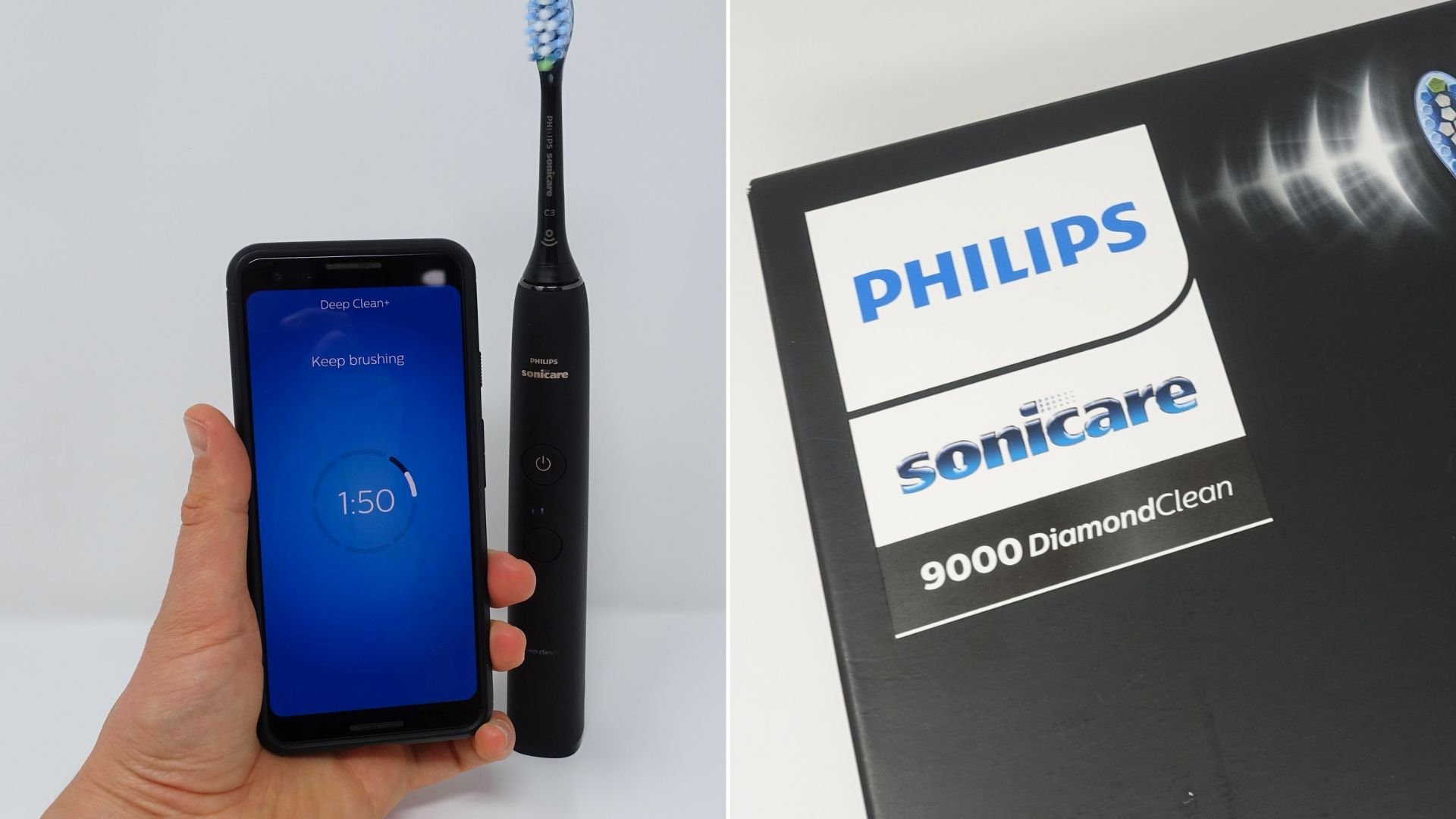
It's a smart enabled toothbrush, but is it the one for you?
The DiamondClean 9000 is a premium toothbrush packed with more features than you need, but able to help you take your oral care to the next level, if committed.
Use it correctly and it cleans the teeth very well.
Despite advanced technology, other brushes offer more smart features, notably real-time tracking for similar or less money.

Pros |
Cons |
|---|---|

Premium design & materials |
Not a visible pressure sensor |

Reminds you when to replace your brush head |
No real-time brushing feedback |

Travel case allows the brush to be charged inside |
Bluetooth connectivity isn’t essential & adds to the cost |
More tech for less money?
The top of the line 9900 Prestige is the ultimate choice with real-time tracking to help you take corrective action immediately, but it will cost more.
If you are not brand conscious, Oral-B's iO6 delivers top end performance and real-time tracking. But further pounds can be saved by opting for the slightly older, but still perfectly capable Genius X.
You could also consider some of the more affordable brushes ranked in our best Sonicare electric toothbrush article.

Design, usability, clean & general use
The DiamondClean 9000 is very much a Sonicare product.
I know that might seem an odd comment, but what I mean is that the design, performance and approach here is as you would expect and it has everything we have seen before on other models.
The box is typical Sonicare design with the brush featured and the key benefits called out.
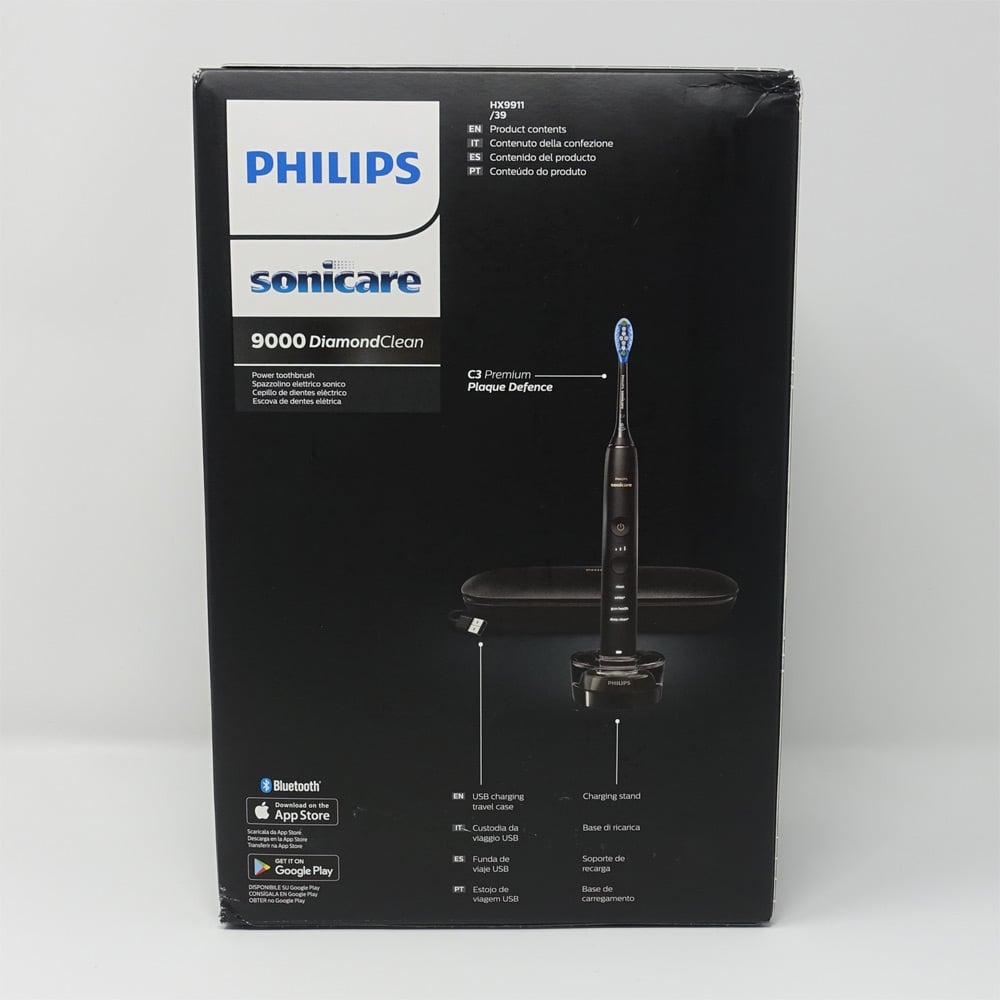
Internal packaging is card, and although some plastic exits it is LDPE type 4 which is theoretically recyclable.
Whilst there is something to be said for a lack of accessories/extra value out of the box, there isn’t a great deal of waste. You get the essentials you need or could benefit from.
For the purpose of this review I have the black coloured handle, but it is available in pink as well as white and rose gold, subject to the variant chosen.
It is a nice array of colour options, although it is the black and pink only at the time of writing that are available as single handled packages.
The brush handle itself is rounded, although not completely circular. It is a little deeper than it is wide.
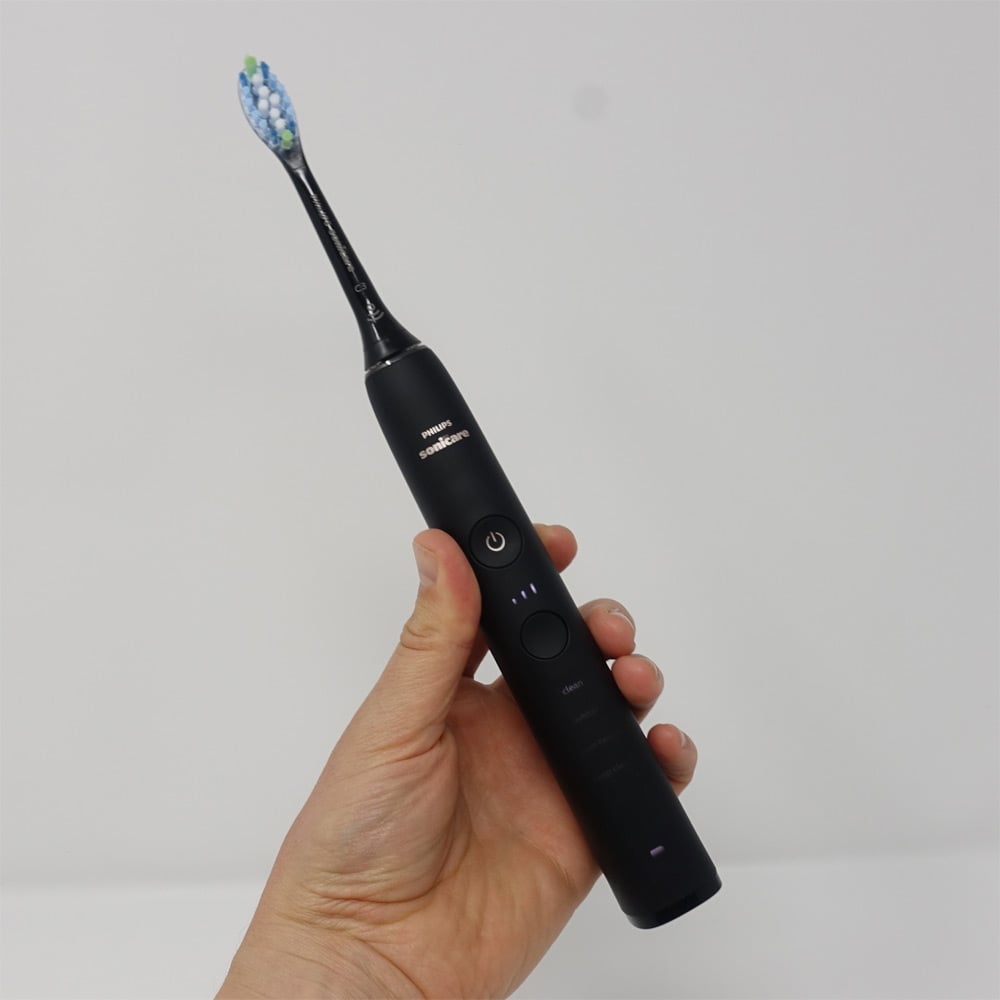
Smooth to the touch, although the DiamondClean lacks any raised rubber grips, it feels premium and comfortable in hand. It is chunky enough to get a good grip on it, but not so large it feels overbearing.
Clearly of a plastic construction the body has a matt look to it. Although smooth, the finish is not all that slippery.
It feels more design over function. If you struggle to grip onto the likes of an electric toothbrush, those brushes with more grips, like an Oral-B toothbrush are likely a better fit for you.
At the very top of the brush handle is where you attach the brush head.
1 x brush head is supplied in the box. This slides onto and off of the metal shaft that extends from inside the brush handle.
The supplied brush head is the C3 Premium Plaque Defence brush head, and in this instance is black in colour to match the brush handle. Although the head is a gloss black plastic compared to the matt black of the handle.
From a side-on view, you will see the head is angled slightly. This is to help with reach to the back teeth.
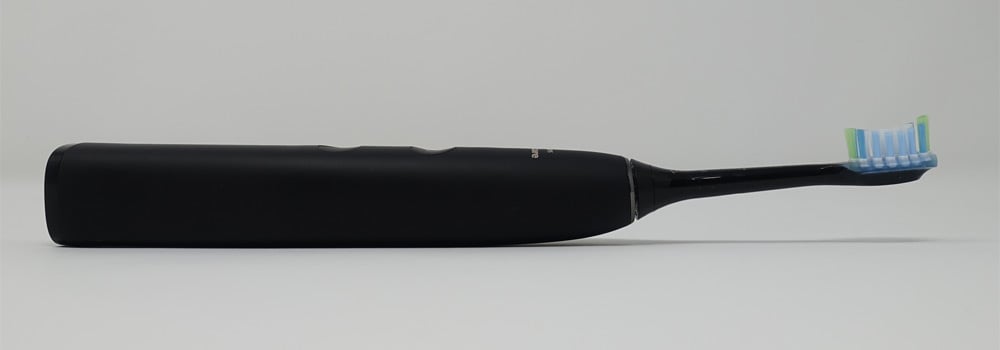
On the front of the brush handle itself is the Philips Sonicare logo. It sits central in the upper third of the handle.
Below this is the first of 2 buttons. It is the power button.
A round button with a concave design, a power icon is printed on it.
The design and placement means that the thumb does naturally fall to it but you don’t get the added texture and resistance of the rubber power button on the likes of the ExpertClean for example.
When pressed it turns the toothbrush on or off. It provides a reasonable feedback to the fingertip.
Beneath the power button are 3 vertical bars. The bars are lined up horizontally and increase in height from left to right.They are not obvious until the white backlight shines through.
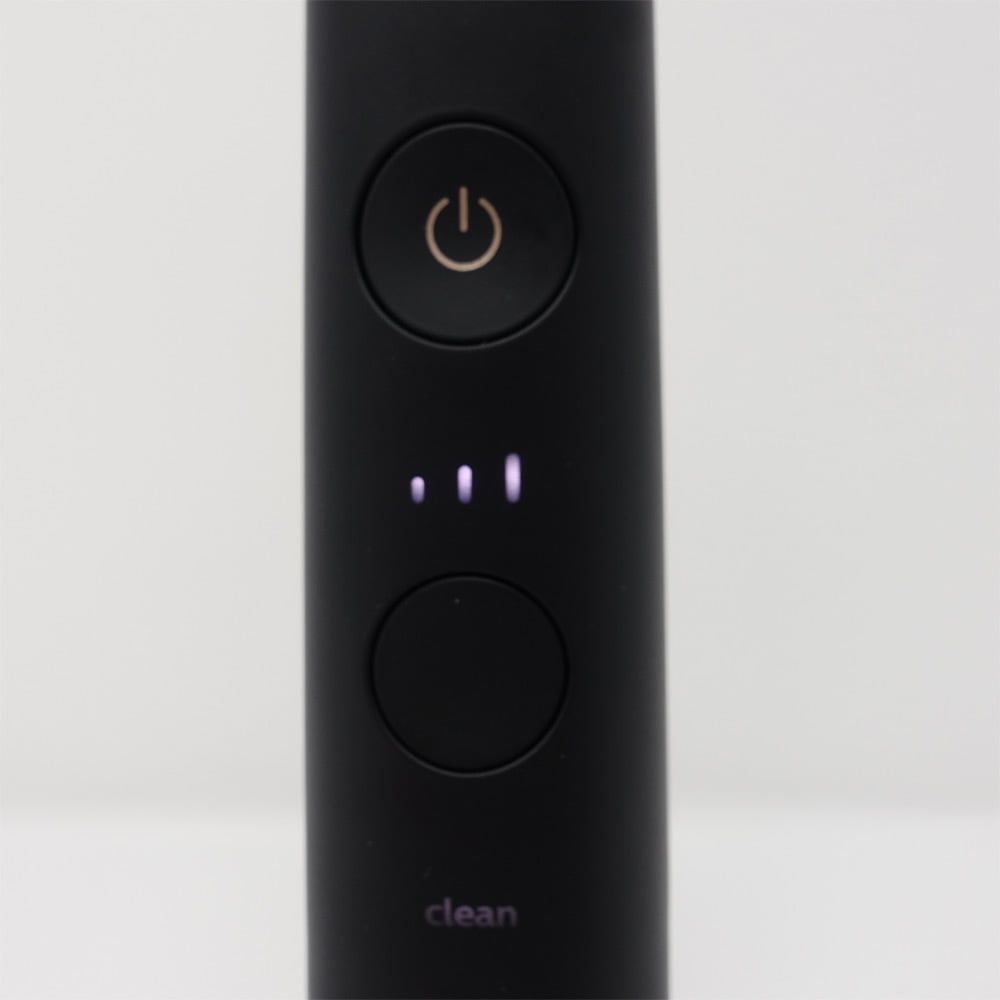
These bars indicate the intensity setting for the cleaning mode being used by the toothbrush.
This intensity setting is controlled via the second and final button on the handle. That button is positioned below the intensity icons.
It too has a concave design. Marginally smaller than the power button there is no icon on it, but it offers a similar feedback to the power button.
This button serves 2 functions.
When the brush is turned off, it changes between the 4 different cleaning modes available.
You can continue to press the button to cycle through the cleaning modes.
The 4 modes are displayed below the mode/intensity button. The modes are backlight with white light.
Press this button when the brush has been powered on and the intensity of the brushing mode will be changed.
As the intensity is changed, the number of vertical bars lit above it changes also.
There are 3 settings, low, medium and high.
- 1 white vertical bar = Low intensity setting
- 2 white vertical bars = Medium intensity setting
- 3 white vertical bars = High intensity setting
The more lights, the more powerful and intense the brushing sensation offered by the brush is.
You can continue to cycle through these intensities as much as you like.
Combine 3 intensities with the 4 brushing modes and you essentially have 12 different cleaning configurations.

As a consequence of the button configuration you cannot change the cleaning mode whilst you are brushing the teeth. You need to turn the brush off or wait for the cleaning cycle to end.
When turned off the names of the cleaning modes that are on the front of the handle are almost invisible. It is only when backlit can you see them.
The same can be said for the next icon, the brush head replacement reminder.
It is a picture of a toothbrush head, with arrows on either side.
This will be lit when it is time to replace the brush head. This is part of the BrushSync technology, which I will explain shortly.
Underneath this is the battery icon.
A single bar, it is generally lit a white colour.
The sides along with the back of the brush handle are free of any extra controls. It is all smooth touch plastic.
The DiamondClean does not have the small raised plastic nodule you sometimes see on the back of a handle. If present it would stop the brush rolling when laid flat on a countertop.
Now the DiamondClean is not so rounded that it rolls a lot. It will lay flat on a countertop, but it could easily end up leaning on the right or left side.
The base of the brush is flat. There is no recess for a prong from a charging stand to fit, because the charging stand configuration is different here.
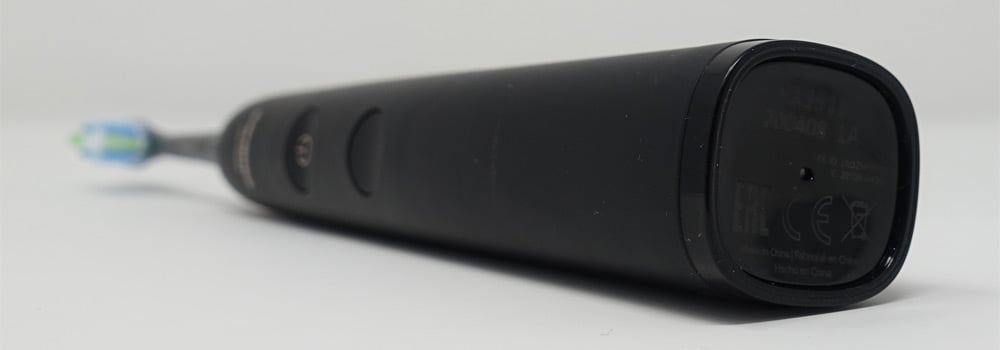
Printed on the base is some regulatory information including model numbers.
I ultimately like the look of the handle. It feels solid, it is not that heavy and the fit and finish appear to be very good. It does lack some extra grip, whip could be useful, but for most, you can still retain a good hold on the brush, even when wet.
Built and sealed inside the brush handle is the rechargeable battery, the brush motor and the other electronic components needed to make this brush function.
Whilst the handle is water resistant, able to withstand a rinse under the tap, exposure to toothpaste, and saliva etc. The manual specifically states not to bathe or shower with it.
Sonicare produces ‘sonic’ toothbrushes. This is a type of cleaning action whereby the bristles of the brush head sweep back and forth very quickly.
At full power, the bristles achieve 31,000 brush strokes, or as Sonicare often quote, 62,000 movements per minute.
The number of strokes and movements do vary from one cleaning mode to another and they are affected by the intensity level set.
The DiamondClean 9000 I am reviewing here has 4 cleaning modes. They are:
- Clean
- White+
- Gum Health
- Deep Clean+
The different modes and the ability to change the intensity setting on any mode means you can find the perfect cleaning action and power level for you.
It is nice to have this very granular level of control.
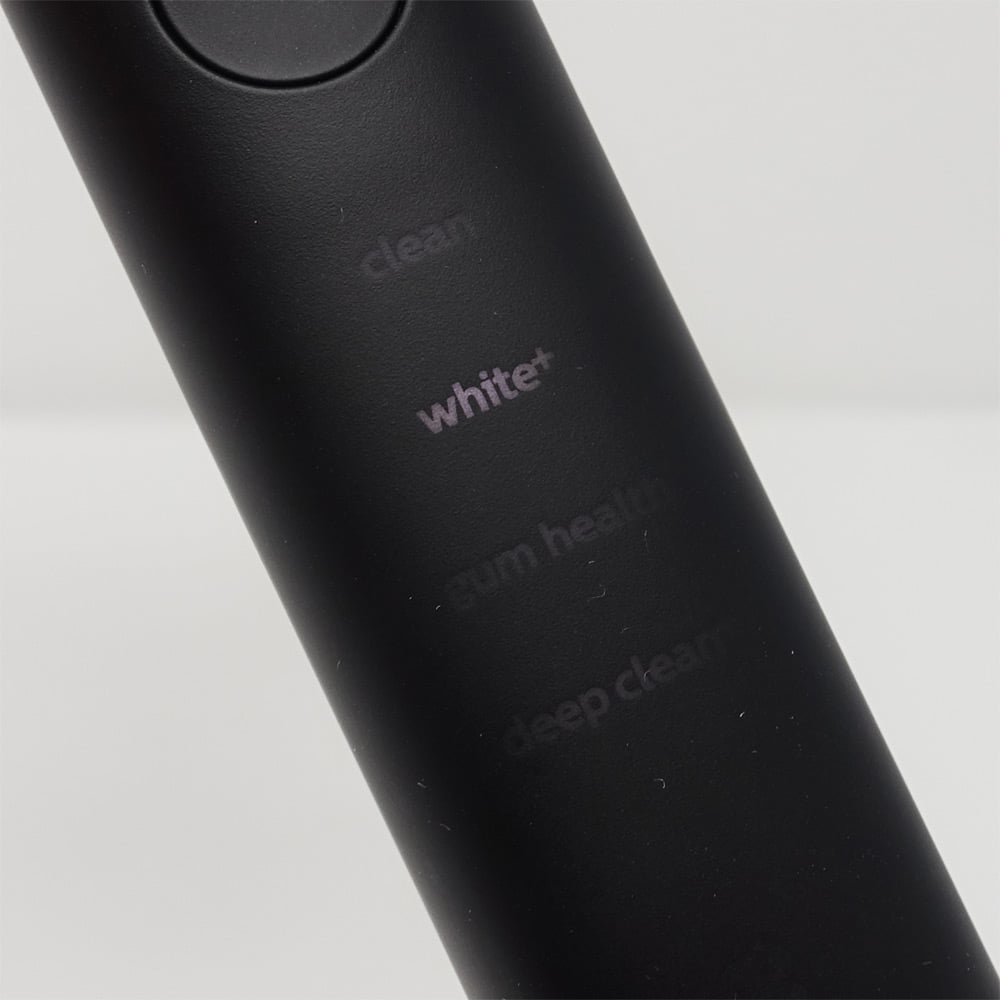
The different modes can help achieve different oral health goals. Deep Clean+ helps with plaque removal. Gum health helps improve the condition of the gums.
Each mode lasts a different amount of time, in order to achieve the best results. They are not all programmed to last the standard 2 minutes.
These modes are not necessarily a make or break factor though. Don’t stretch yourself to afford this brush, just because it has a Deep Clean+ mode.
Have a read of my Sonicare cleaning modes post if you would like to learn more about each cleaning mode and what it is designed to do.
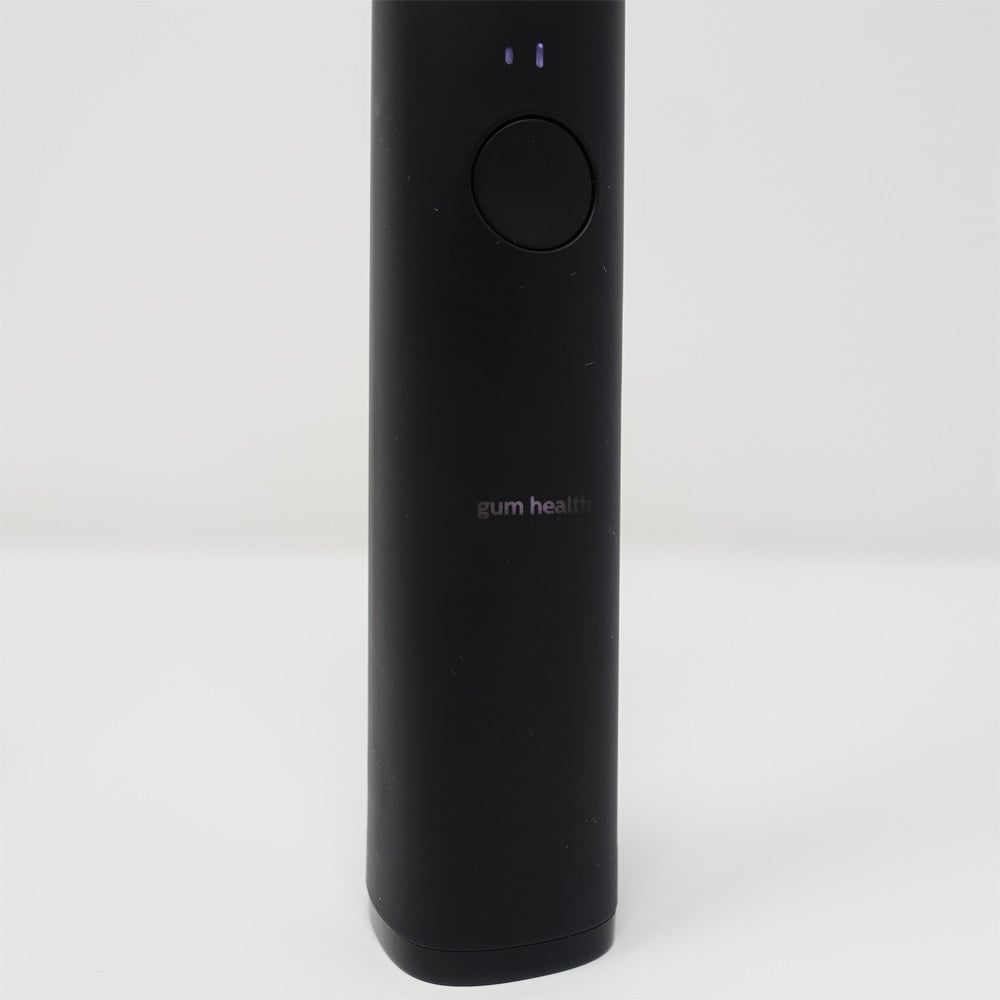
The DiamondClean does clean the teeth really well. I have little in the way of complaints here. After each use, my mouth felt clean and fresh. I felt like I achieved good coverage with the brush head. At no point was I disappointed.
I do personally prefer the Oral-B cleaning action and brush head size. The smaller round head feels like I can move it around the mouth with a touch more ease. The cleaning sensation feels more intense and deeper, which I prefer. That said, I know many who would take the Sonicare cleaning action over and above Oral-B.
Let me now cover some of the other essential or not so essential tech built into this brush.
An essential feature is the timer and pacer.
These help you and me brush for 2 minutes and brush the teeth evenly.
Dentists recommend, as a general rule, brushing for 2 minutes twice a day.
This is all well and good, but there is little benefit if the 2 minutes is spent brushing just the front teeth. You need to clean all surfaces of the teeth, front, back and tops, in both the upper and lower jaw.
This is where the timer and pacer come in.
Both are activated the moment the brush is turned on. The pacer kicks in via a slight pause in the motor movements, at set intervals. This pause causes a change of sound and variation in the brushing sensation. This is your cue to move from one area of the mouth to another.
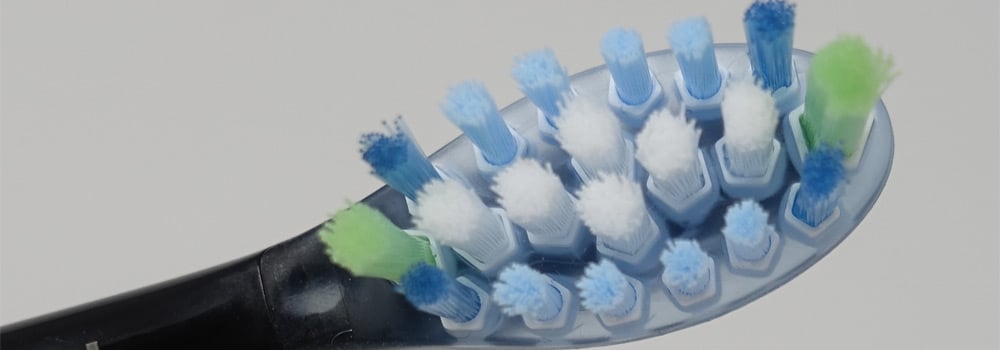
Typically, it is advised to break the mouth up into 4 sections, upper right, upper left, lower right and lower left. The idea is 30 seconds are spent on each section of the mouth. After 2 minutes the result will be a fairly even clean across all teeth.
However, Sonicare has implemented this slightly differently. When using the DiamondClean 9000 the pacer has been set to 20 second intervals.
This results in 6 sections of the mouth to brush.
- 1 -- Upper right back teeth
- 2 -- Upper front teeth
- 3 -- Upper left back teeth
- 4 -- Lower left back teeth
- 5 -- Lower front teeth
- 6 -- Lower right back teeth
The 6 sections and 20 seconds intervals still result in the same brushing time, it is just a slightly different approach.
As you clean each section, you need to make sure you brush the front, back and top surfaces of the teeth.
Doing this should help ensure all teeth get an even clean and you help maintain your smile.
The timer ensures the pacer kicks in at the right points and is tied into another near feature, the automatic power off.
At the end of a cleaning mode the DiamondClean will automatically power itself off at the end of the cleaning cycle. Should you wish to brush for longer you will need to turn the brush back on again.
Because the 9000 has multiple cleaning modes and some, notably the Gum Health and Deep Clean modes you need to understand how to work with the pacer in these circumstances to achieve the best results.
The image below gives more information on the approach to use.
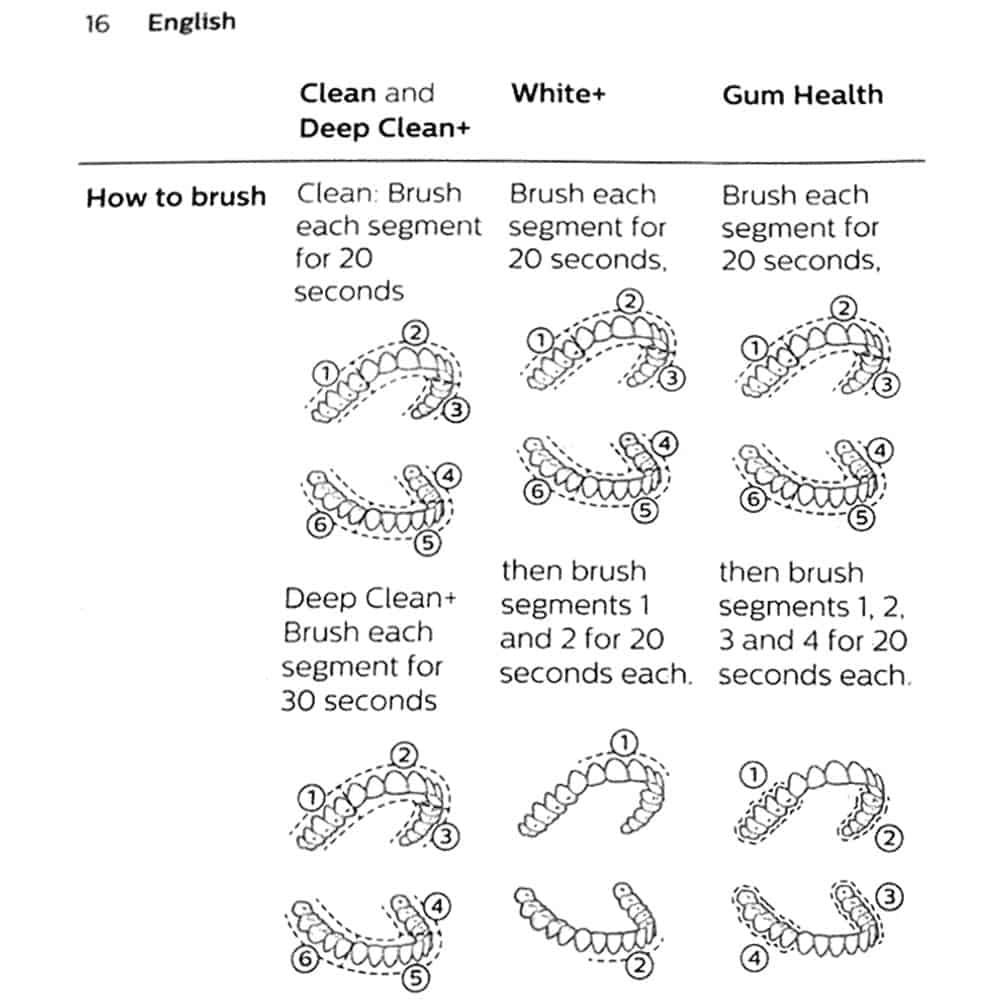
The DiamondClean has another handy feature built-in, a pressure sensor.
Applying too much pressure can be damaging to the teeth and gums so the sensor is there to help prevent this.
It is not a visible pressure sensor that you see on many Oral-B models. This is a shame as the light can often catch the eye, particularly if brushing in front of a mirror like many people do.
Instead, if the handle detects too much force being used, it will reduce the power of the brush motor. This avoids doing unnecessary damage to the teeth. The brush will also change the vibrating motion felt in the hand to help alert you.
Once the pressure is relieved, the motor will return to full power and any changes in handle vibration stopped.
It is particularly useful for new electric toothbrush users who are less familiar with the pressure required when brushing.

The bristles need only really skim the surfaces of the teeth and gums, there is no need to scrub.
This pressure sensor will kick in as many times as is necessary during use. You will quite quickly learn how much pressure to apply when brushing.
Moving onto less essential but very useful tech built into the DiamondClean, we have BrushSync technology.
I have created a comprehensive guide to BrushSync, that explains in detail how it works.
In short, there are 2 key parts to the technology, both of which are enabled on the 9000.
- Brush head replacement reminder
- Mode pairing
On average you should replace a brush head every 3 months (90 days).
This is where the brush head replacement reminder comes in. The LED on the brush handle is lit when it is time to replace the head. A bold visual reminder.
However, if you frequently use excessive pressure, or use longer brushing sessions, the bristles will wear sooner. This will, in turn, mean you are alerted to replace the head sooner. The brush will intelligently alert you based on the feedback it gets.
Each head is tracked by the handle, via an radio-frequency identification (RFID) chip that is built into each brush head. So, even if you use multiple heads it alerts you only when it needs to for that specific head.
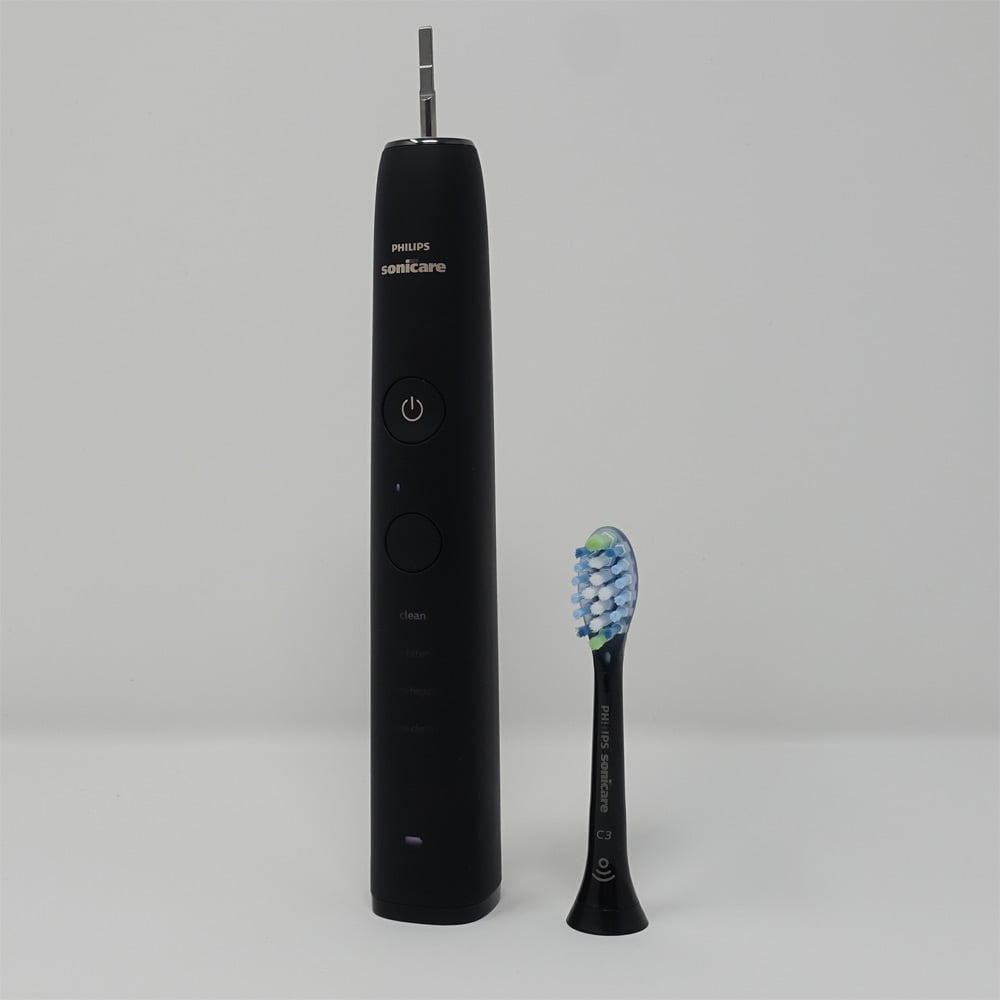
Mode pairing also uses the RFID chip to select the most appropriate mode based on the head fitted.
For example, the C3 Premium Plaque Defence brush will select the clean mode when fitted. Attach the G3 Premium Gum Care brush head and the gum health mode will be selected. This helps give the optimum clean. You can override these settings if you wish.
The final and a fairly significant piece of technology left to speak about is the Bluetooth technology that allows the brush to connect to a smartphone.
The Sonicare application required is free to use and available for Android and iOS mobile devices.
You do not have to use this technology if you don’t want to.
But, do be considerate that you are paying for such premium tech in the price. So, if you really don’t want Bluetooth, you are better off opting for a different brush.
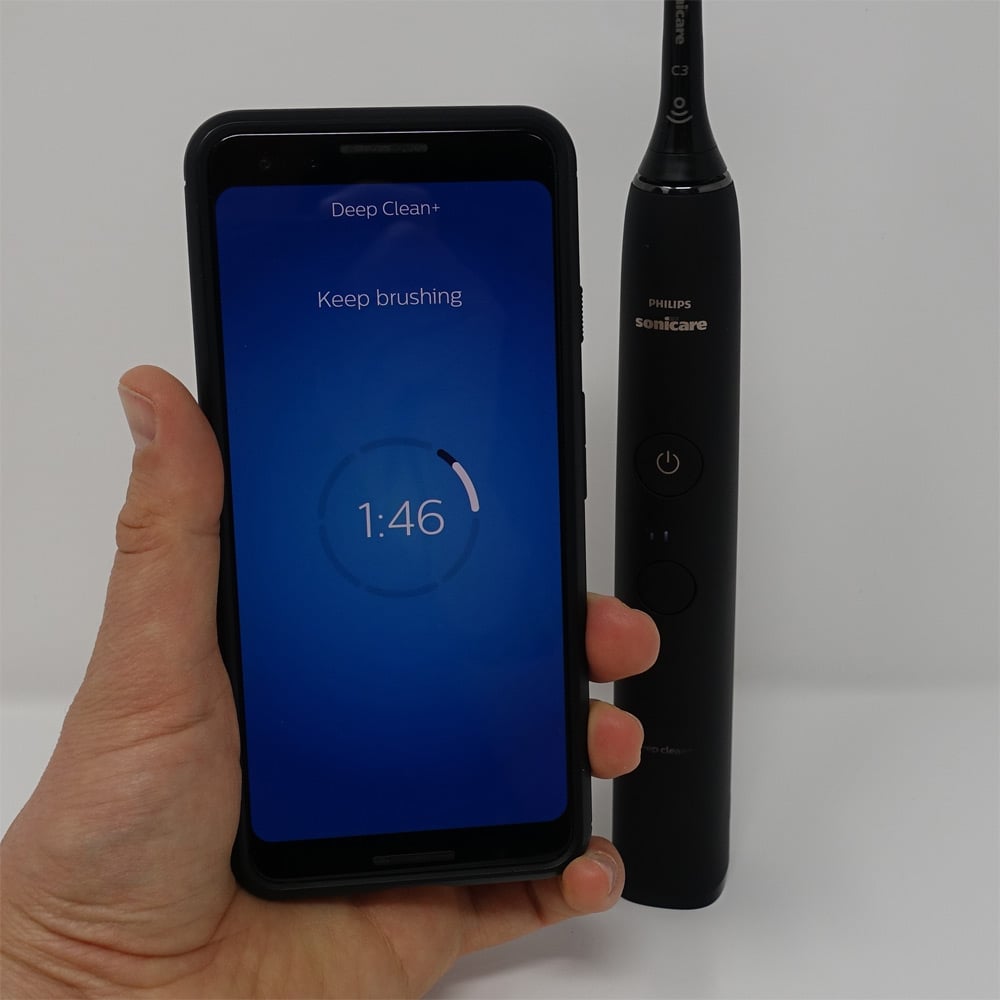
The principle behind this connection is that the brush will share key data with the app which is then logged.
The app then provides feedback based on the data it obtains.
For example, if you brushed infrequently, with too much pressure, the app would let you know this along with helpful tips on how to achieve better standards.
The main progress screen shows the average time per session and per day. It also shows the pressure levels used.
Green icons are good. Orange icons highlight areas you need to work on.
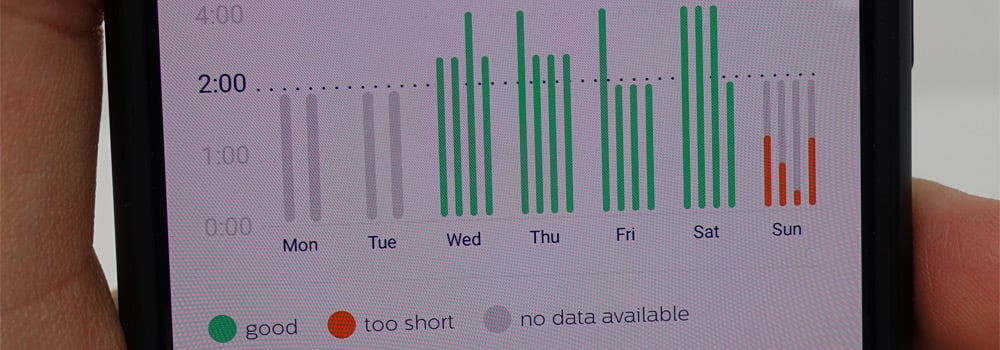
This information is helpful for sure, particularly for new electric toothbrush users.
You are given data for the last 7 days only. It would be preferred if this data went back further, for as long as you have been using the brush. Sadly it does not. Sonicare used to offer this feature.
Within the app, it gives you details about the brush heads you have been using. It will log each one and show how many brushing sessions you have left.
You can within your profile set details about yourself. You can also get more information about your particular brush handle, as well as update the software that your brush handle is using.
A ‘tools’ section of the app allows you to shop for new products such as brush heads and add in dental information such as your next dental appointment.
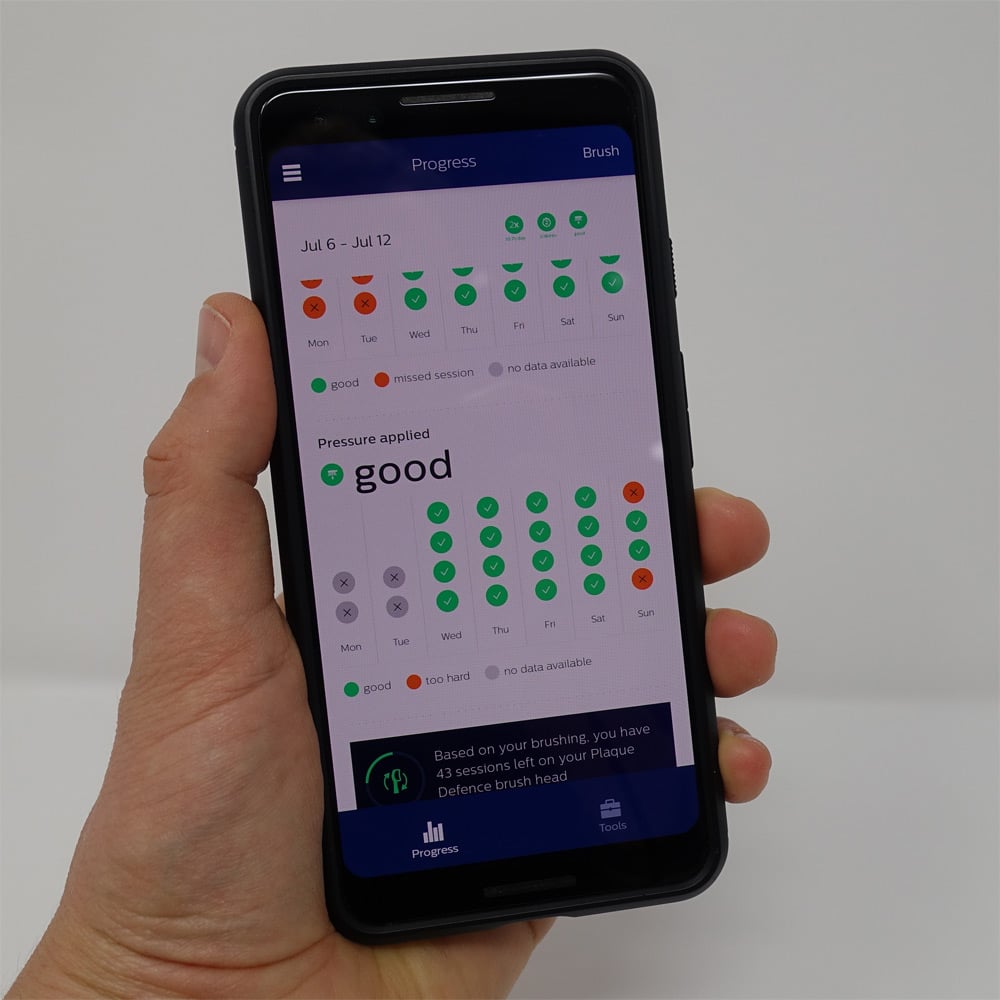
You don’t have to use the app with the brush each time. The handle will retain some data and sync with the app next time you open it.
Sonicare I think have done an ok job with the app. Initial setup and configuration are straightforward and I had no issues pairing the app with the brush. That said there is room for improvement. Configurations of the app available for other models (DiamondClean Smart) offer more data. I think there is more scope for better education within the app.
An important point to note is how the implementation of this Bluetooth connection is different with the DiamondClean 9000 compared to the DiamondClean Smart or brushes from other brands like the Oral-B Genius X or iO.
Unlike these other modes, the DiamondClean 9000 does not offer real-time brushing feedback.
You can get an on screen timer as you brush. It shows you how long you have left to brush and what area of the mouth you should be focusing on. This will alert you if brushing too hard. But this timer isn’t actually tracking the position of the brush in the mouth as you brush.
The DiamondClean essentially only transfers brushing data to the smartphone app, after the brushing is complete.
With brushes that do offer real-time tracking, sensors in the brush handle transmit data to the smartphone instantly, so you can correct brushing errors as they happen. This is usually shown on screen via clear visuals of the mouth, using colour to highlight clean and unclean areas of the mouth.
Whilst neither approach is essential, the real-time option can potentially be more useful to some. It gives a more accurate visualisation of faults in the cleaning and more meaningful data on how and what to improve. There is also less delay (in theory) between detecting and resolving the issue.
What is on offer here is still useful. But, when you have used the other models as I have, you realise what you are missing.
Add to this the fact that Oral-B offers more cost effective brushes with real-time tracking, is the DiamondClean lagging here?
I am being picky. But at this price point, I believe I should be. Particularly when, although marketing materials might not explicitly state real-time tracking, buyers may be led to believe this is what you get.
I suspect Sonicare could update the app and handle firmware to allow this, but I am not 100% sure.
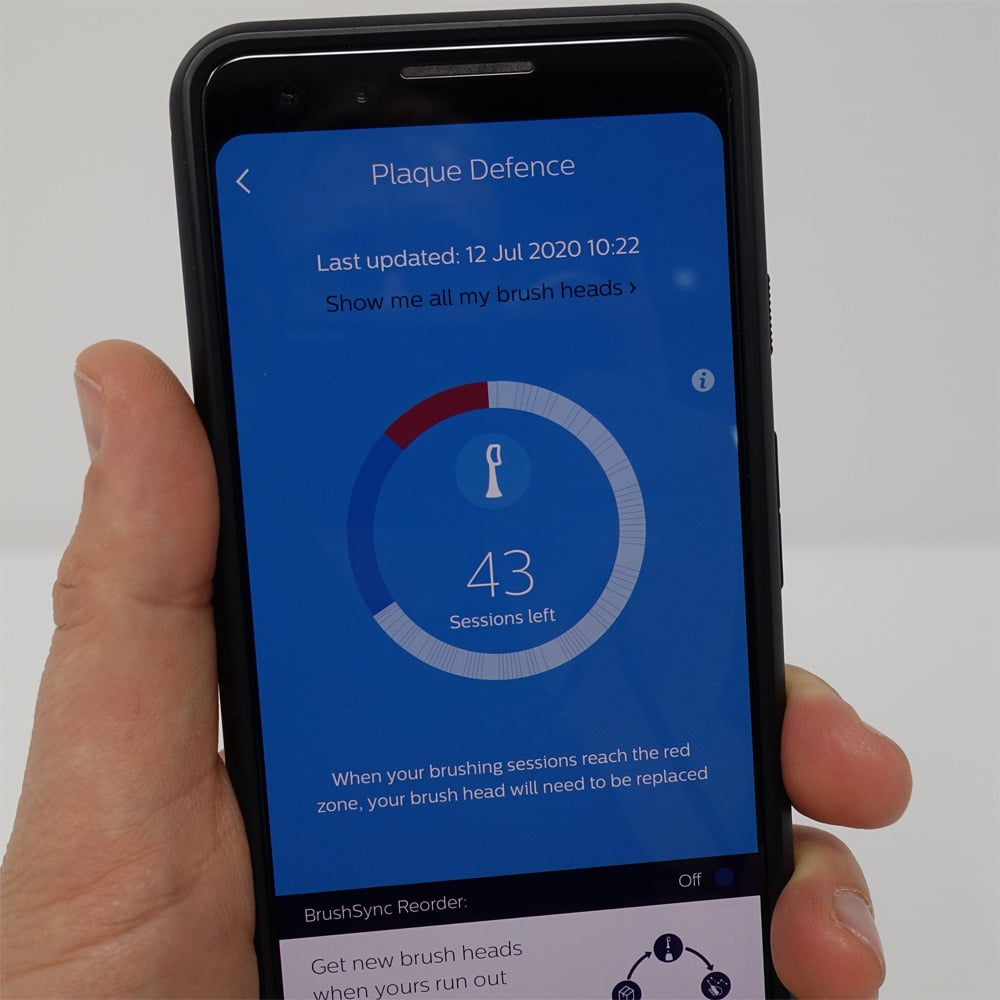
That is all the tech in the DiamondClean covered.
As for the accessories you get in the box…
1 x C3 Premium Plaque Defence brush head is supplied.
This is just 1 of a range of brush heads available and compatible with the DiamondClean 9000.
My comprehensive guide to Sonicare brush heads, explains a lot of what you would want to know about the varying styles you can get.
The C3 brush head is very nice, but you might want to consider the C2 Optimal Plaque Defence. It lacks the rubber coating on the back of the head, but cleans just as well. It might also be a bit cheaper.
A charging stand is provided, more on that in the battery life section of this review.
Aside from the documentation the only other accessory is the USB travel charging case.
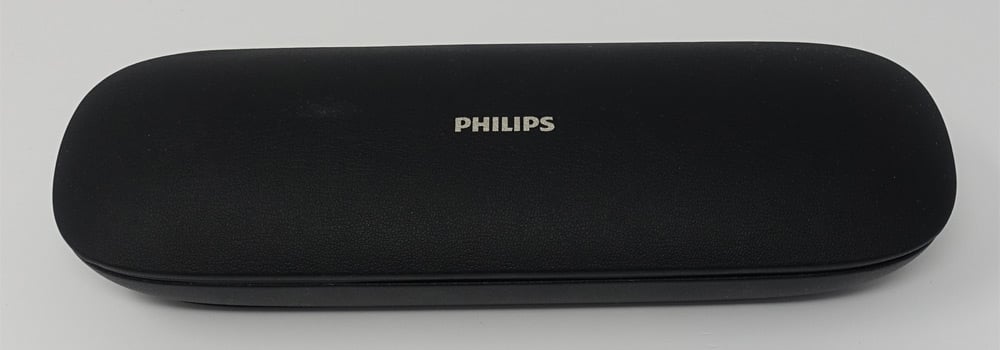
I love this accessory. It is an example of a product done right.
Travel cases are not essential, but even for the infrequent travellers, they make it nice and easy to store, transport and protect the handle and up to 2 heads.
This is definitely a premium accessory and is basically identical to that provided with the DiamondClean Smart.
It is a touch bulky and is of primarily plastic construction, although the lid has a pu leather style material on the top for a premium look and feel.
If held horizontally it hinges on the top edge and opens up like a jewellery box might.
Inside you side the handle and up to 2 heards.
On the underside, accessed via a removable cover is a USB cable that is hard wired into the case. A full size USB Type A connector is provided.
Connect this to an appropriate socket and the brush is charged whilst in the case.
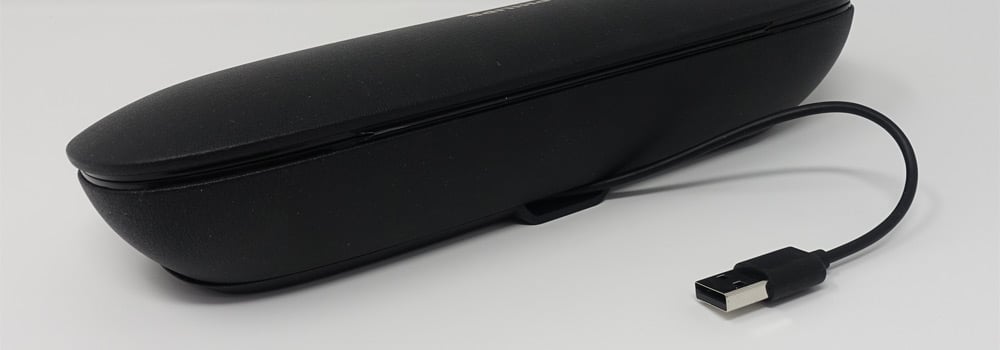
The cable is not detachable like the ExpertCleans travel case.
What this ultimately means is long trips away don’t require you to take the charging stand.
The provided manual is not quite as thorough as manuals included with other models, which is a little disappointing. Given the price I would have expected slightly better.
An extra brush head or 3 would not have gone a miss, nor would some sort of brush head storage compartment. But, I guess if these were offered these would be even less point in the DiamondClean Smart.
As standard, the brush comes with a 2 year warranty that covers faults as a result of faulty parts or workmanship, not user damage.
Summary of design, usability, clean & general use
Battery life
As is the case with the majority of electric toothbrushes, the DiamondClean 9000 has a rechargeable battery sealed inside.
It is not user removable.
It is a Lithium-Ion (Li-Ion) battery as is the case with the vast majority of rechargeable toothbrushes today.
Sonicare have a fantastic track record of battery life on their brushes and the 9000 DiamondClean is no exception to this rule.
Personally I feel Sonicare sell themselves short in terms of how well they perform.
The advertised battery life is 14 days.
This is the absolute minimum you would get from the brush.
In my hands-on testing I achieved 22 days.
This is equivalent to 44 brushing sessions.
This was using ‘Deep Clean+’ which is 3 minutes long. I had the intensity set to high. As I understand it, this is the most power intensive mode.
This is 8 days longer than advertised by Sonicare!
The different cleaning modes and the ability to change the cleaning intensity can all have a bearing on the total usable time you will get from the battery.
When I completed the same test using the standard ‘Clean’ mode that lasts for 2 minutes I achieved an even more impressive 33 days (4.7 weeks) from the brush. That is equivalent to 66 brushing sessions.
Had the intensity been set to low, I am sure I would have gotten a few extra sessions.
As a general rule I expect a toothbrush to last at least 2 weeks. I see this as a bit of a benchmark as this is a common time period to go on holiday for etc. So, with the 9000 you are going to be absolutely fine.
On the handle of the DiamondClean is a battery icon. This gives some feedback on the status of the battery when in use and when being recharged.
This is one place where I think the cheaper ExpertClean is better. It has a battery icon broken into 3 sections, which gives a bit more of a guage about the remaining battery life than the DiamondClean does, in my opinion.
When the battery power is getting low, approximately 10% or less, the battery indicator lights up an amber/yellow colour rather than the default white. You also get 3 beeps from the handle.
When the battery is completely flat the brush will beep 6 times and will not power on.
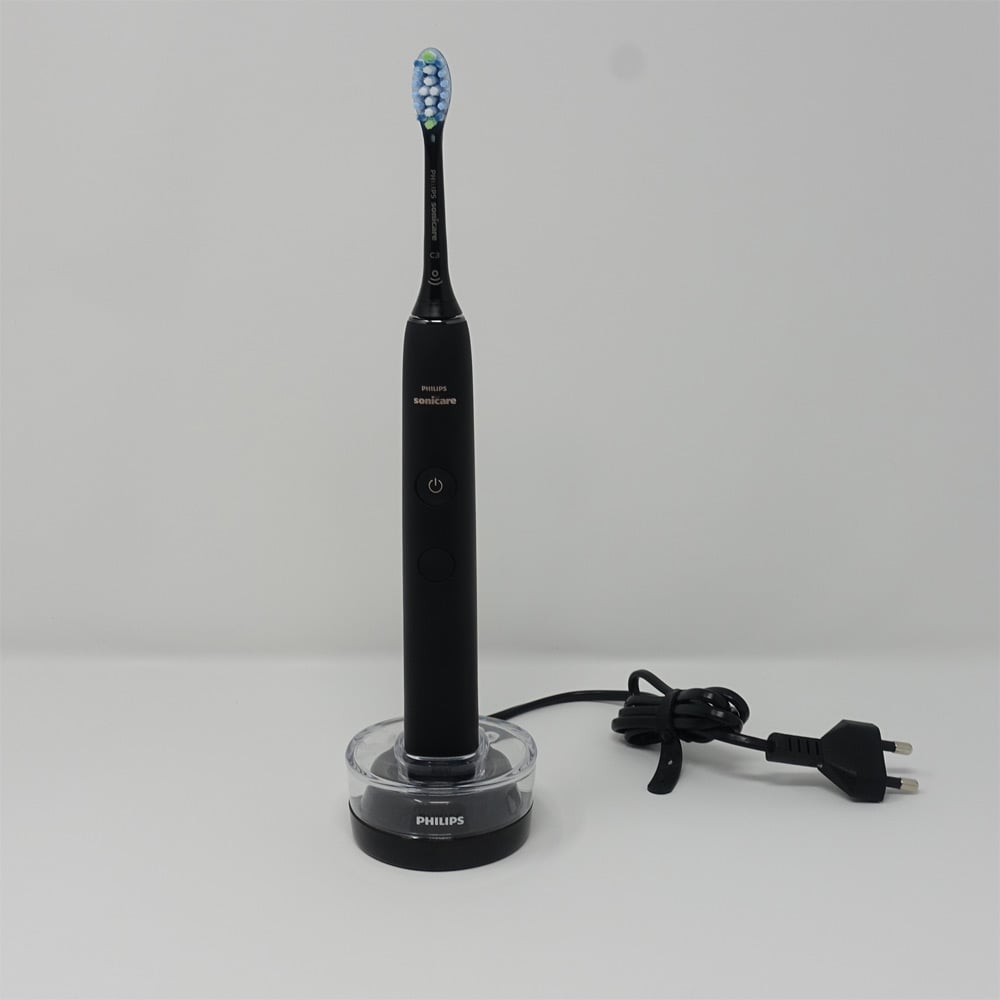
Pop the brush into the charging stand and the battery icon pulses white until the DiamondClean 9000 toothbrush is fully charged. At this point the light stops pulsing.
It takes up to 24 hours to fully charge.
This charging time is longer than most other brushes, but then the battery life is quite a bit longer. Given that you don’t always need to access it, no big deal in my mind.
Provided in the box is a charging stand.
The stand is not like most stands you get with electric brushes and is in part where the DiamondClean stands out as a more premium option.
It is made up of 2 parts, a charging base and what Sonicare calls a charging glass.
The ‘glass’ is actually a clear plastic frame that sits on top of the base. It offers a perfectly sized cutout in the middle into which the handle of the 9000 fits.
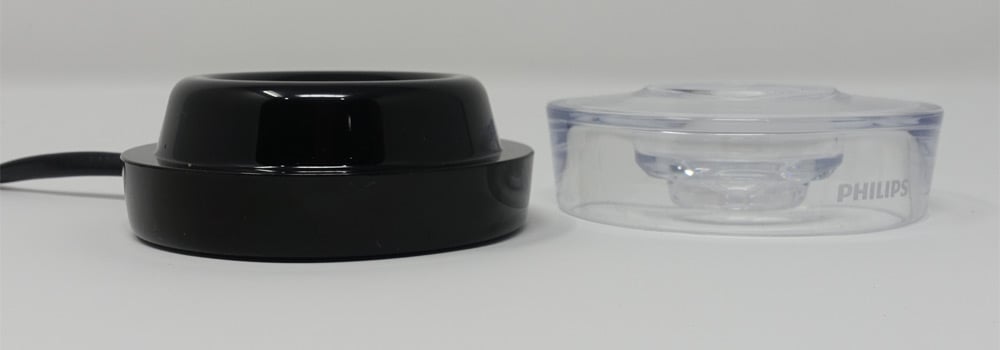
It does look a little more classy than the conventional charging stand, but it is a little larger in its overall size.
The colour of the base does depend on the colour of the handle you buy.
Hardwired into the base is a 100-240v power adapter. It has a 2 pin configuration, this is to be connected to the power supply (shaver socket) found in a bathroom here in the UK.
Some homes (mine included) are not equipped with such. It is possible to connect to a 3 pin socket by using an adapter. You would need to purchase this seperately.
For those who are interested, the power cable to the charging base is about 1.2 meter (4 foot) in length. And because it supports 100-240V if travelling you will require only a plug adapter and not a voltage adapter.
An alternative option for charging the 9000 is the provided charging case.
This premium travel case looks classy and has a USB cable hard wired into the base.
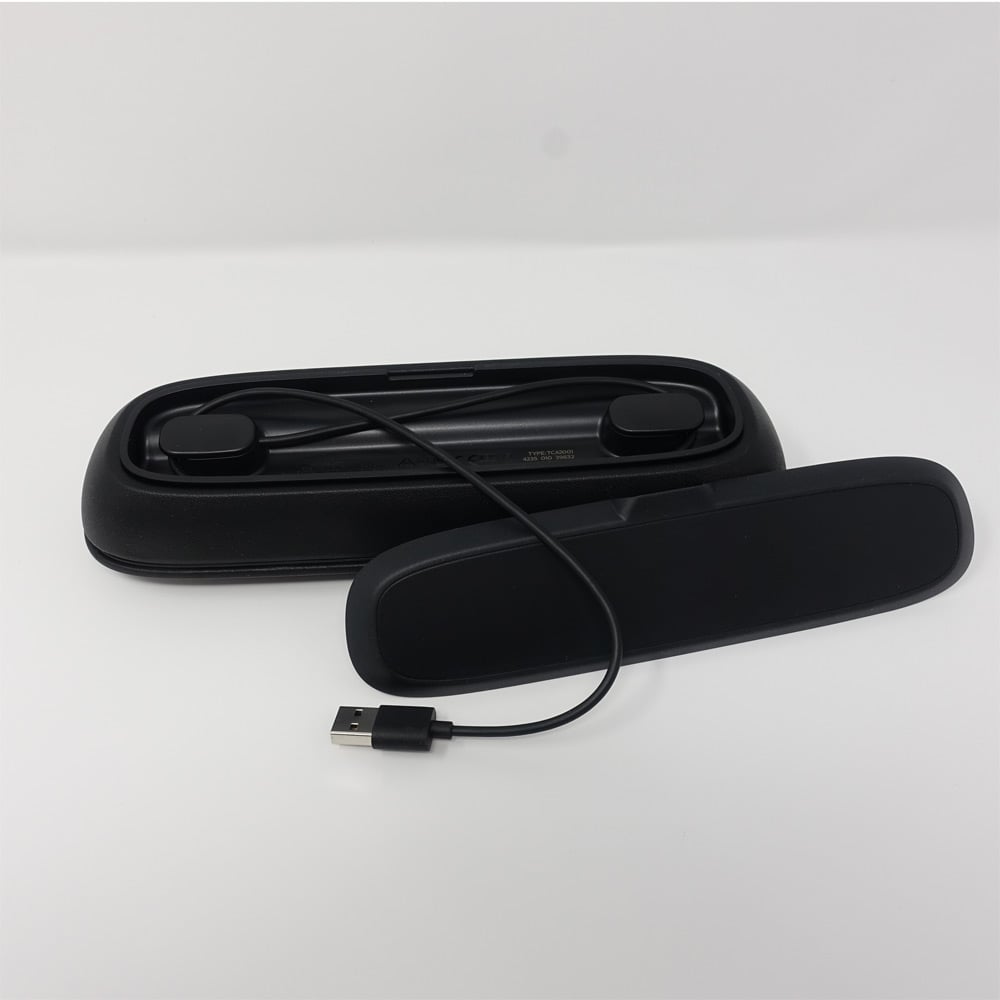
The cable has a full sized USB Type A connector that can be connected to a USB port on a computer, battery bank or plug adapter.
There is no battery in the travel case itself, so you will only be able to charge it when actually connected to a power source.
When not in use this cable can be neatly wrapped inside the compartment on the bottom of the case, accessed via a removable rubber panel.
When placed on the charging stand or within the case, the handle will vibrate twice with 2 audible beeps to act as confirmation that the brush is now being recharged.
The accompanying smartphone application does provide some feedback on the battery status, but hidden away in a menu. What is displayed is not a helpful percentage (%) that I hoped for. Instead, the words high, good and low. It is better than nothing for sure.
Summary of battery life
Price & where to buy
I have included links to buying options here at the start of the review.
In the section below, I discuss the price more generally and in relation to similar products.
Price and what a product is worth is of course subjective.
We each have a different perception of what we might consider cheap, good value or expensive.
It is perfectly possible to get a functional electric toothbrush for under £20.
Increase that budget to around £40-50 and you will be able to get yourself a very strong performing, good quality toothbrush. At this price it will likely have what I deem to be the essential features you need.
In essence for £50 or less anybody can acquire a more than satisfactory toothbrush, that when used correctly will if not improve, help maintain a good standard of oral health.
With this in mind, the retail price tag of £340 for the DiamondClean 9000 seems, well, very expensive.
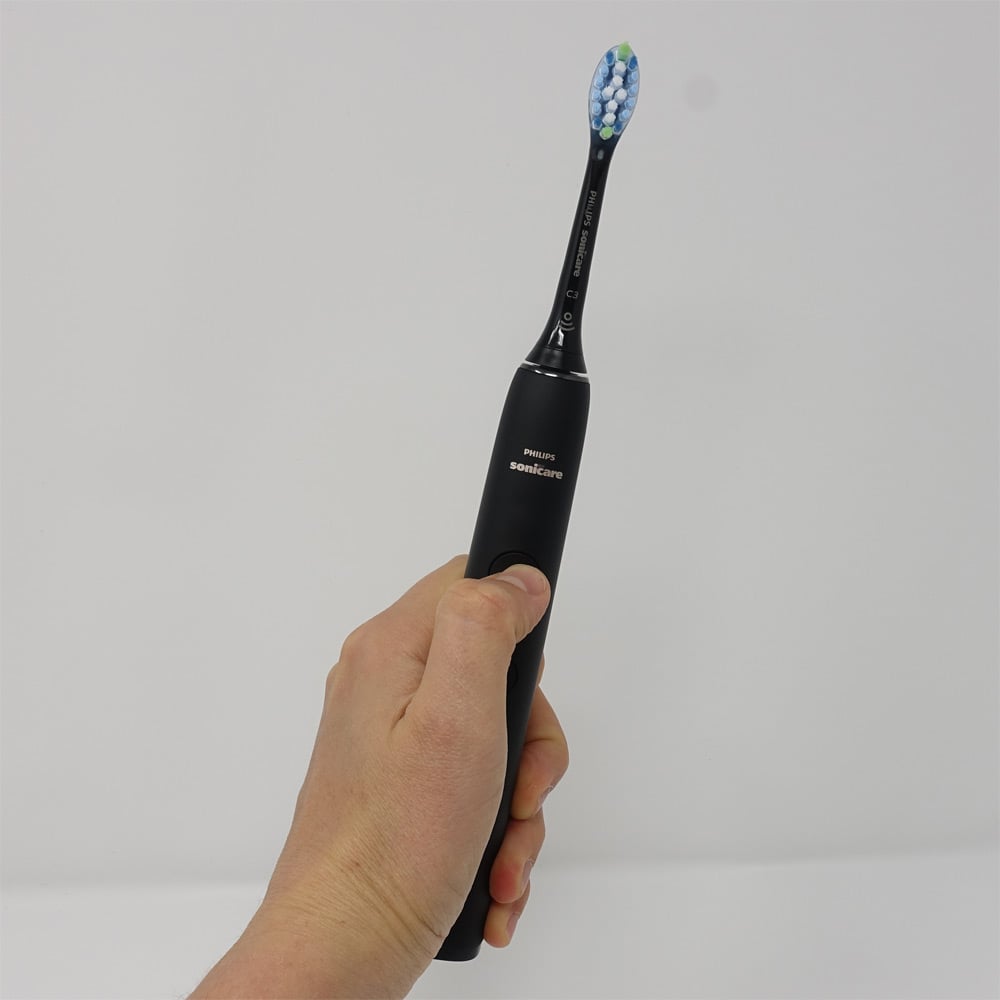
Is it worth the 7x premium over a regular brush? No.
Simply put, I do not advise anyone to pay this price, or anything remotely close to this.
For some context, what I will say is...the Sonicare DiamondClean Smart toothbrush is the only brush above the DiamondClean 9000 in the Philips range.
Launched about 3 years ago, with retail prices of around £340-380 it is perhaps not surprising that this new model has a £340 price tag.
The Smart variant is technically still the more premium model. If based on retail prices alone, it could arguably be the better buy given the extra accessories included in the box.
Things tend to get a little more complicated as the actual selling price of electric toothbrushes in the UK and Europe tends to fall between 20-50% less than their suggested retail price.
Although it would be argued otherwise, the prices are over-inflated intentionally.
With this in mind, the price drops to £272 with 20% off or £170 with 50% off.
Perhaps unsurprisingly the £170 seems a much more realistic price point.
After approximately 3 years on the market, the DiamondClean Smart 9700, the top of the line model has an average selling price of £250, a 30% discount on retail.
My gut feel is the price of the 9000 will hover around the £170-200 on average.
In the box, you get a single brush head, but over the lifetime of the brush, you will need to purchase more.
Whilst prices are always subject to change a standard toothbrush head will cost around £6 and requires replacement every 3 months.
However, the DiamondClean 9000 doesn’t use standard brush heads. It makes use of BrushSync enabled heads, which averages around £7 per head.
Use of the standard heads does make ownership more cost effective, but the brush head replacement tracking and mode pairing benefits would be lost.
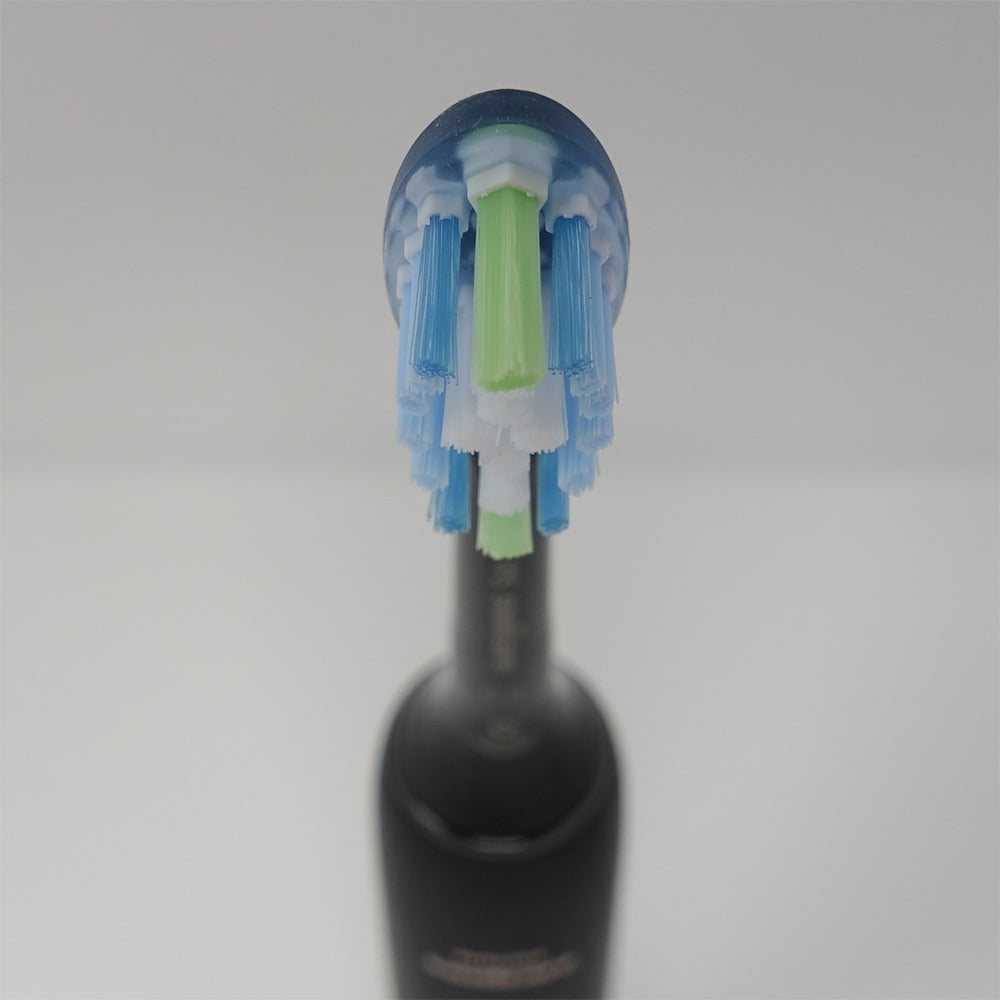
Assuming 1 user, replacing their brush heads every 3 months, over a 3 year period will result in an additional cost of £77.
Add this to the cost of buying the DiamondClean 9000 in the first place and you are looking at an ownership cost ranging from around £247 (170+77) through to £349 (272+77) over 3 years.
This equates to 23p through to 32p per day, assuming a purchase price of 20-30% below retail.
If you paid full retail for both the brush handle and the heads, the ownership cost would be staggering.
Sonicare’s range topping DiamondClean Smart 9700 works out on average at 29p per day over 3 years. Very little difference.
Whilst it is of course your decision, I encourage you to pay particular attention to the Sonicare ExpertClean 7300.
The ownership cost is a lot less and you retain the majority of benefits you get with the DiamondClean. The daily cost is approximately 17p.
You should too consider the Oral-B Genius X, at 18p per day. It is a different brand with similar yet different features, but you get real time tracking.
Please note that all prices quoted are approximates and will vary based on location, supplier and time of purchase. These figures were correct at the time of writing and should not be relied upon as hard fact, but used as a guide during your decision process.
Summary of price & where to buy
Reliability & long term use
Whilst reliability of Sonicare toothbrushes on the whole is very good, the original DiamondClean did appear to have some reliability issues.
I don’t have the data to conclusively say one way or the other, but anecdotal evidence from my own research, comments and feedback I have gotten has suggested this.
For whatever reason a number of brushes failed relatively early on within their life. And whilst the majority were replaced by Sonicare under the warranty terms, some customers even had replacement units fail.
Ultimately only long and extended periods of use by multiple users will really indicate whether there are any inherent problems. My couple of weeks testing has not turned up any hardware faults.
No doubt Sonicare will have learnt from past experience and the handle design is now used widely across the Sonicare range. With so many models using the same chassis I do believe the likely risk of failure remains extremely low.
The good news is that should the worse case happen, you have the 2 year manufacturer warranty that you can take advantage of
Conclusion
The DiamondClean 9000 is a truly superb electric toothbrush.
Introduced to replace the DiamondClean models that came before it, the improvements are sensible and appropriate.
It is a lovely brush to use, not just because you can achieve a great clean of the teeth. There are other parts to the overall package, such as the charging case that make the whole user experience feel more enjoyable.
For me there are 2 overarching issues that make it difficult to really recommend this toothbrush.
The first is the lack of real-time tracking available in the smartphone app when brushing the teeth. No, you don’t need this. But, similar products offer such and it would be easy to believe the DiamondClean might offer such, even if it is not actually advertised in this way.
For real-time tracking you need the Sonicare 9900 Prestige or iO models.
The second issue is the price. It is very expensive.
Yes, the price is appropriate given the other products in the Sonicare range. But for the vast majority there is little justifiable reason to spend as much as is asked for here.
Oral-B's Genius X or iO Series 6 delivers better value for money.
Size guide
- Toothbrush height with head - 25.5cm / 10 inches
- Toothbrush height without head - 19.5cm / 7.7 inches
- Width - 2.6cm / 1 inches
- Depth/thickness - 3cm / 1.2 inches
- Weight with head - 142g / 5oz
- Weight without head - 136g/ 4.8oz
- Travel case size - 23.2cm / 9.1 inches (L) x 7.2cm / 2.8 inches (W) x 5cm / 2 inches (D)
- Travel case weight - 188g / 6.6oz without brush or 330g / 11.6oz with brush
- Package weight - 520g / 18.3oz
Noise
- 71dB
Country of manufacture
- China



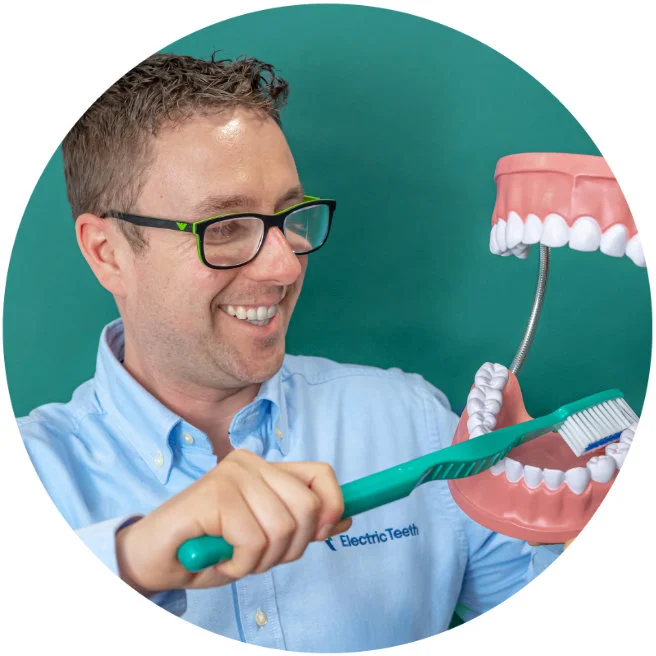

hello, I would like to know which one to buy, Philips Sonicare DiamondClean 9000 model hx9913/81 which is on sale at cotsco for 179.99 or oral-b io series 6 Model 80373477 for 169.99 These two models, both come with 2 brushes in the box
Both are good brushes. I would opt for the iO6. I think you get more for your money, particualrly with the smart features.
thank you and happy thanksgiving
Thorough review - thanks. Whilst you have said that the lack of a visible pressure warning is a con (the Philips has a vibrate warning), this of course is not a con if the user has a sight disability, or indeed if the user isn’t in front of a mirror. So, it seems like a questionable con. I appreciate the thorough review and will check out your other ones as I’m new to the site.
Thanks for the feedback David. Indeed I agree for those who have a sight disability this would not be a con. I have tried to take the approach of reviewing this for the vast majority of individuals but recognise that many with particular needs or disabilities will potentially assess the pros and cons differently.
Thanks, Jon. I don’t have a sight disability myself, but it could be that Philips are thinking of a wider demographic in their design and function choices which was the point I was really trying to make. Anyway, great site.